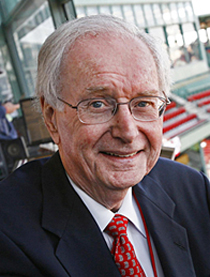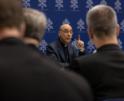
Culture
He was the first man in baseball history ever to lead the league in both most home runs and fewest strike outs in the same season.

Flavin
Do you remember Tommy Holmes? If you're an old-timer, you might, but even if you do, it's probably been years since you've even thought of his name.
Tommy was one of the most popular baseball players ever to put on a Boston uniform. That's saying a lot, since this town has rooted for, and given its heart to, beloved figures with names like Mookie, Big Papi, Pedro, Nomar, Yaz, the Little Professor, and Teddy Ballgame. Tommy Holmes was right up there with them on the popularity charts. And he didn't even wear a Red Sox uniform, he played for the old Boston Braves.
The Braves left town in 1953, right after Holmes' playing career ended, which is one reason why he has faded from memory. But he was a terrific player. He was an outfielder, playing mainly in right, where he was the Pride of the Jury Box in Braves Field. That box had nothing to do with a court of law, it referred to a stand-alone section of bleachers in right field, which could seat up to 1,500 fans, although there were usually far fewer than that in attendance. It got it's name when a sportswriter counted just 12 people sitting out there during a game. But those who were there, along with just about everyone else, loved Tommy Holmes. He would wave to them and lift his hat when he took his position between innings, often engaging in a dialogue with the fans out there. Attendance was often so sparse that he didn't have to raise his high-pitched voice very much in order to be heard.
The reason he comes to mind is that 2020 marks the 75th anniversary of the remarkable year he put together in 1945. His production was such that he put up numbers that would make even Ted Williams jealous. He batted .352; he led the major leagues in home runs with 28; he also led the majors in hits, with 224; doubles, with 47; extra base hits, 81; and total bases, 367. Added to that was that between June 6 and July 9 that year, he hit safely in 37 consecutive games, setting a National League record, which stood for more than three decades until broken by Pete Rose in 1978.
Perhaps most remarkable of all is that in 714 plate appearances that year he struck out only nine times (that is not a typographical error!). He only swung and missed on a third strike one time all year. Talk about a contact hitter. He was the first man in baseball history ever to lead the league in both most home runs and fewest strike outs in the same season.
Over the course of his career, he struck out only 122 times in 5,563 plate appearances. To put that into context, in 2019 the Red Sox had five players with at least that many strike outs in a single season, and Rafael Devers, with 119 Ks, almost made it six.
1945 was a magical year for Holmes, but not for his team. The Braves finished in sixth place in the eight team league with a record of 67-85. That probably is the reason that he lost out in the Most Valuable Player voting to Phil Cavarretta, first baseman of the pennant-winning Chicago Cubs, who edged him out for the batting championship on the final day of the season with an average of .355.
Granted, there were some extenuating circumstances for Tommy's great season. In 1945, World War II was just winding down and many, if not most, of baseball's greatest stars were still serving in the military. Players like Ted Williams, Joe DiMaggio, and Stan Musial were wearing the uniform of their country, not of their teams. Also, the dimensions of Braves Field, which changed often over the years, were particularly beneficial to a left-handed line drive hitter like Holmes that season. The distance down the right field line was just 320 feet and in center it was only 380. With an 8-foot fence to clear it was an easier home run target than Fenway Park's left field, which was only 310 feet down the line but had its famous (or infamous) 37-foot high wall to clear. The easy target worked out well for Holmes, whose 28 round-trippers were by far the most he ever hit (his next highest total was 13, the only other time he had more than nine homers in a season). It did not work out so well for the Braves, however. It resulted in more home runs, but most of them were hit by opposing players. The fences were moved back the following year but nowhere near to the park's original dimensions, which were gargantuan. When Braves Field first opened in 1915 it measured 402 feet down the left field line, 461 to center before leading to a far away corner in right center which was an unbelievable 542 feet from home plate; right field was a more reasonable 375 feet. The park was built during the dead-ball era, but the age of Babe Ruth and home runs was just around the corner.
Tommy never again had a year like 1945, but that is not to suggest he was a one-year wonder. In '48, the year the Braves won the pennant, he hit .325, and he had a lifetime average of .302.
The Three Troubadours, consisting of a trumpet, a clarinet, and a trombone, used to wander through the stands of Braves Field, playing songs for the fans between innings. Holmes, who was called by his childhood nickname, Kelly, by his pals on the team, was always serenaded whenever he came up to bat by the Troubadours with the old music hall song, "Has Anybody Here Seen Kelly?" making him possibly the first player ever to have his own walk-up song, which is so common-place nowadays.
It's been 67 years since the Braves suddenly pulled up stakes and moved to Milwaukee at the end of spring training in 1953, and who could blame them? Always second-fiddle to the Red Sox, they had drawn only 281,278 fans the year before, an average of less than 3,800 per game.
Despite the herculean efforts on the Boston Braves Historical Society, memory of the team grows more hazy with each passing year; and the legacy of Tommy Holmes, who was such a great fan favorite and who had such a remarkable season in 1945, grows ever dimmer. His story should be told.
- Dick Flavin is a New York Times bestselling author; the Boston Red Sox "Poet Laureate" and The Pilot's recently minted Sports' columnist.
Recent articles in the Culture & Events section
-
'Dignitas' and the mediaRussell Shaw
-
Scripture Reflection for April 14, 2024, Third Sunday of EasterDeacon Greg Kandra
-
St. Helena's House is established in the South EndThomas Lester
-
Is this synodality?Russell Shaw
-
Poking the hornet's nest of IVFFather Tadeusz Pacholczyk


















